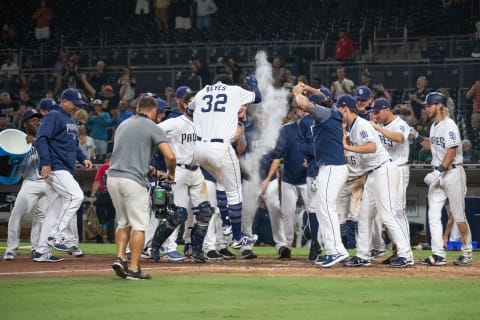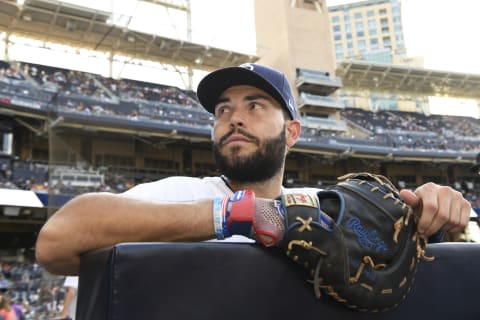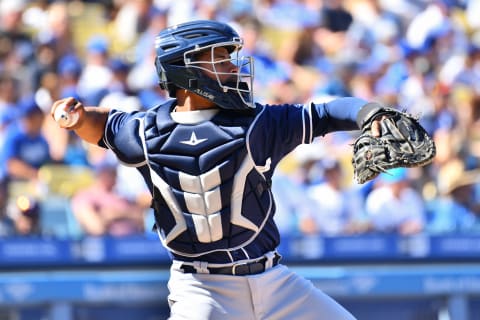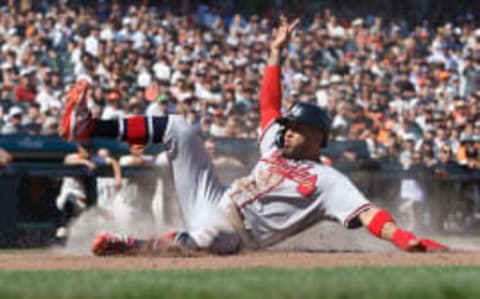San Diego Padres 2018 season review


Even after signing Eric Hosmer to an expensive, long-term contract, the San Diego Padres failed to improve upon their 71-91 record from 2017.
The last time the San Diego Padres were over .500 was in 2010, when they were 90-72 and finished two games behind the San Francisco Giants in the NL West. They also finished just a game behind the Atlanta Braves for the wild card spot that year. In the eight years since then, they’ve won an average of 72 games per year and haven’t come close to a playoff spot.
Despite eight years of losing records, the Padres attendance has barely changed. They drew 2,131,774 fans in 2010, when they were 90-72, and 2,168,536 fans in 2018, when they finished 66-96. In a year in which more than half the teams in baseball saw a drop in attendance, the Padres were in the minority as they had slightly higher attendance this year than they did in 2017.
Heading into the 2018 season, the Padres had one major asset—a highly regarded farm system. The young players in the minor leaguers weren’t expected to lead the team to contention just yet, but they gave fans hope for the future. After finishing 71-91 in 2017, they were projected by Fangraphs and Baseball Prospectus to have the same win total in 2018. Clay Davenport was much more pessimistic, projecting them to win just 58 games.
There was a reason for this. The 2017 Padres finished 71-91, but with a -212 run-differential, the worst in baseball. Their expected record based on their run-differential was 57-105. While fans may have considered them a 71-win team in 2017, they were actually closer to a 57-win team.
In that sense, winning 66 games this year wasn’t the big step back it looked to be. Based on actual wins, they went from a 71-win team to a 66-win team. Based on run-differential, which is generally a better indicator of the caliber of the team, they went from a 57-win team to a 64-win team (their expected record this year was 64-98).
Before we get to what went right and what went wrong this season, let’s look at some of the moves they made last offseason.

2018 Padres: Offseason Moves
Shortly after last year’s World Series ended, the Padres let four major league players go to free agency—shortstop Erick Aybar and pitchers Jhoulys Chacin, Jordan Lyles and Craig Stammen. Aybar ended up playing the 2018 season in the Mexican League. The Padres later re-signed Lyles and Stammen. Chacin signed a two-year deal with the Milwaukee Brewers for $15 million. Chacin had a better year with the Brewers than any pitcher the Padres had on their roster.
In mid-December, the Padres made a pair of trades. In one, they sent Jabari Blash to the Yankees for Chase Headley and Bryan Mitchell. Headley had some good years with the Padres from 2010 to 2013, but didn’t contribute anything this year and was released in May after hitting .115/.233/.135 in 27 games. Mitchell wasn’t much better, finishing below replacement-level with a 5.42 ERA and 6.11 FIP in 73 innings.
A few days later, the Padres traded relief pitcher Enyel De Los Santos to the Phillies for shortstop Freddy Galvis. Santos spent most of the season in the Phillies’ minor league system. Galvis was the Padres everyday shortstop, but he wasn’t particularly good (.248/.299/.380, 1.2 WAR).
In late December, they signed Tyson Ross as a free agent. He had a 4.45 ERA (4.55 FIP) in 123.3 innings before the Padres lost him on waivers to the Cardinals in August. Lyles met a similar fate. He was lost on waivers to the Brewers in August.
Of course, the big move of the offseason was the free agent signing of Eric Hosmer for eight years and $144 million. The contract pays Hosmer $105 million in the first five years, then $39 million over the next three, with an opt-out after 2022. This was the big, bold move the Padres made to signal that they were serious about building a contender. Ideally, Hosmer would anchor the club by providing production at first base for the next half-decade (more on this in the “What Went Wrong” section).
The Padres’ season started in late March when they were swept at home by the Milwaukee Brewers, then lost three of four to the Colorado Rockies. They were 10-20 at the end of April, sitting in last place and already 11 games out. It was not a good start.
Then, for a three-month stretch, the Padres went 37-45. That’s not going to get a team to the playoffs, but it’s a 73-win pace over a full season. That’s at least on the road to respectability.
Unfortunately, July happened and July was ugly for the Padres. They went 5-20. At one point, they lost 14 of 16. In the middle of this dreadful stretch, they decided to cash in a couple of their relief pitchers for a top prospect. They traded Brad Hand and Adam Cimber to Cleveland for catcher Francisco Mejia (more on this in the “What Went Right” section).
The team recovered from July to finish out the year with a 24-28 record in August and September. They also provided some big league experience to a pair of their top prospects, the aforementioned Mejia and second baseman Luis Urias. There are more prospects coming in the next few years. In the meantime, let’s take a look at what went right for the 2018 San Diego Padres.

2018 Padres: What went right?
Not much went right with the San Diego Padres offense. They didn’t hit for average (.235 batting average) or for power (.380 slugging percentage) and were particularly bad at getting on base (.297 on-base percentage). Their on-base percentage was the lowest in baseball. If you’re looking for some positives with the bats, the choices are limited.
The brightest spot among hitters was outfielder Franmil Reyes, who came up from the minor leagues in May and hit .280/.340/.498 (129 wRC+, meaning he was 29 percent better than average on offense after league and ballpark effects were accounted for; 100 is league average). In a little over half a season, Reyes launched 16 home runs. His calling card is big power. Not only did he hit 16 big flies in the big leagues, he also hit 16 in Triple-A. This came after he hit 25 dingers in Double-A in 2017. He’ll be 23 years old next season and should be a fixture in the lineup.
Another guy with a productive stick was outfielder Hunter Renfroe, who led the team in home runs and was second in RBI. Renfroe hit .248/.302/.504 (114 wRC+) and had 26 homers for the second season in a row.
Third baseman Christian Villanueva had an above average season on offense (.236/.299/.450, 104 wRC+, 20 homers in 110 games), but it comes with an asterisk. He absolutely crushed the ball in April, when he hit .321/.411/.692 and had eight of his 20 home runs. Then his bat went missing for three months. In May, June and July, he hit .184/.227/.360. He recovered to hit well in 15 games in August before a fractured finger ended his season.
The three players mentioned so far were all above average on offense but either didn’t have the playing time or the proficiency on defense to be average players overall. No Padres position player produced 2 WAR, which is league average. Wil Myers came closest. He had 1.6 WAR in 83 games, which would make him an above average player over a full season. Unfortunately, he missed considerable time with an oblique injury.
The top pitcher on the Padres was reliever Craig Stammen (2.73 ERA, 2.19 FIP, 2.3 WAR). He didn’t get any saves but was the most effective pitcher on the roster. The team leader in saves was Brad Hand (24 saves. 3.05 ERA, 3.18 FIP, 0.7 WAR), who was traded along with Adam Cimber to Cleveland in July for catching prospect Francisco Mejia.
According to Baseball America, Mejia was the 20th-ranked prospect in baseball prior to the 2018 season. MLB Pipeline had him 11th on their top-100 and Baseball Prospectus had him all the way up at 5th. He spent most of this year in Triple-A, where he hit .293/.338/.471. He’s one of the good, young players the Padres will build the team around.
After Hand was traded, Kirby Yates took over the closer’s role and finished with 12 saves, a 2.14 ERA, 2.54 WHIP and 1.8 WAR. He, along with Stammen and Hand, helped the Padres relievers finish second in baseball with 8.8 WAR. Only the New York Yankees were better.
The starting rotation was not good, finishing 28th in WAR, but Joey Lucchesi wasn’t terrible. He had a 4.08 ERA and 4.31 WHIP. More importantly, he was one of the few starting pitchers on the Padres with a strong strikeout rate. He had 145 whiffs in 130 innings.
While the 2018 Padres weren’t very good on the field, they had a nice moment off the field when Trevor Hoffman was inducted into the Baseball Hall of Fame. Hoffman is an icon in San Diego, where he played 16 of his 18 years in the major leagues. He is second all-time in career saves. Only the great Mariano Rivera had more.

2018 Padres: What went wrong?
There were worse players on the Padres than Eric Hosmer, but they weren’t making $21 million in the first year of an expensive long-term deal. When the Padres signed Hosmer in February, he was coming off his best season. In 2017, he hit .318/.385/.498, good for a 135 wRC+. Overall, he had a 4.1 WAR season, which is all-star caliber play. This year, he hit .253/.322/.398, which gave him a 95 wRC+ and -0.1 WAR.
This continued a bizarre trend for the Hoz. Going back to the 2012 season, his WAR totals are a roller-coaster ride: -1.4, 3.1, -0.2, 3.5, 0.2, 4.1, -0.1. In odd-numbered years, he’s averaged 3.6 WAR per season. In even-numbered years, he’s averaged -0.4 WAR per season. It doesn’t make any sense and it’s likely not predictive of anything, but it’s something that’s happened.
Eric Hosmer's roller-coaster career (Fangraphs WAR). It's not predictive of anything, but interesting to look at. pic.twitter.com/98INmUVpPA
— BobbyBaseball (@bballonthebrain) October 25, 2018
The two least productive Padres were Jose Pirela (-0.8 WAR) and Carlos Asuaje (-0.7 WAR). They both spent considerable time at second base, which was a big reason the team finished 26th in baseball in WAR at that position. Pirela, specifically, was a big disappointment because he had been a 2 WAR player in 83 games in 2017. He went from being 20 percent above average on offense to 22 percent below average.
While the bullpen was a bright spot on the team, the starting rotation really struggled. Clayton Richard led the team in starts and innings pitched, but had a 5.33 ERA and 4.68 FIP. Eric Lauer and Robbie Erlin had ERAs in the 4.00s. Bryan Mitchell (5.42 ERA) and Luis Perdomo (7.05 ERA) were even worse.
Of course, the Padres defense didn’t do their pitching any favors. They finished 25th in baseball in defense, according to Fangraphs. One of their biggest offenders was Eric Hosmer, who regularly ranks poorly in the defensive metrics even though many people swear he’s a great fielder.

2018 Padres: Outlook for 2019
Even with the $21 million owed to Hosmer, the Padres have the lowest estimated payroll in the National League. The player with the second-highest salary is Wil Myers, at $5.5 million, although his contract escalates to $22.5 million per year from 2020 to 2022. As things are now, the lineup, rotation and bullpen look like this:
Live Feed class=inline-text id=inline-text-3
House That Hank Built
C—Francisco Mejia/Austin Hedges
1B—Eric Hosmer
2B—Luis Urias
SS—???
3B—Wil Myers
LF—Hunter Renfroe
CF—Franchy Cordero/Manuel Margot
RF—Franmil Reyes
INF—Christian Villanueva
INF/OF—Jose Pirela
OF—Travis Jankowski
INF—Corey Spangenberg
SP—Clayton Richard
SP—Joe Lucchesi
SP—Robbie Erlin
SP—Jacob Nix
SP—Eric Lauer
CL—Kirby Yates
RP—Craig Stammen
RP—Matt Strahm
RP—Jose Castillo
RP—Kazuhisa Makita
Last year’s starting shortstop, Freddy Galvis, is a free agent, so the team will need someone there to prevent ground balls to the left side from going straight into the outfield. They just so happen to have one of baseball’s best prospects and he plays shortstop, but Fernando Tatis, Jr. just finished his age-19 season and hasn’t played above Double-A. The Padres aren’t likely to rush him.
Tatis is the top prospect in what is generally considered to be baseball’s best farm system. The Padres ranked #1 on the farm system rankings at Bleacher Report in August. Tatis, Jr. was one of six players who were given Tier 1 rankings. Four others received Tier 2 rankings. Tier 1 players are “prospects who have an elite skill set and All-Star potential” Tier 2 players are “prospects who have a good chance of becoming impact contributors at the MLB level.”
Two of those highly-ranked Padres prospects, catcher Francisco Mejia and second baseman Luis Urias, are ready to contribute in 2019 after getting some big league time this year. The other Tier 1 guys—pitchers MacKenzie Gore, Adrian Morejon and Chris Paddack—have yet to pitch in Triple-A, so it could be a couple years before they arrive.
Next. Padres 2018 minor league awards. dark
In the meantime, the Padres should be better next year than they were this year. Hosmer is talented enough to once again bounce back from a bad year. Myers played 157 and 155 games in 2016 and 2017 before last year’s injury-shortened season. If he’s back out there for a full season, it should greatly help the offense. Mejia and Urias also give the team legit bats at positions that didn’t provide much production in 2018. The Padres won’t unseat the Dodgers at the top of the NL West just yet, but the future is bright.